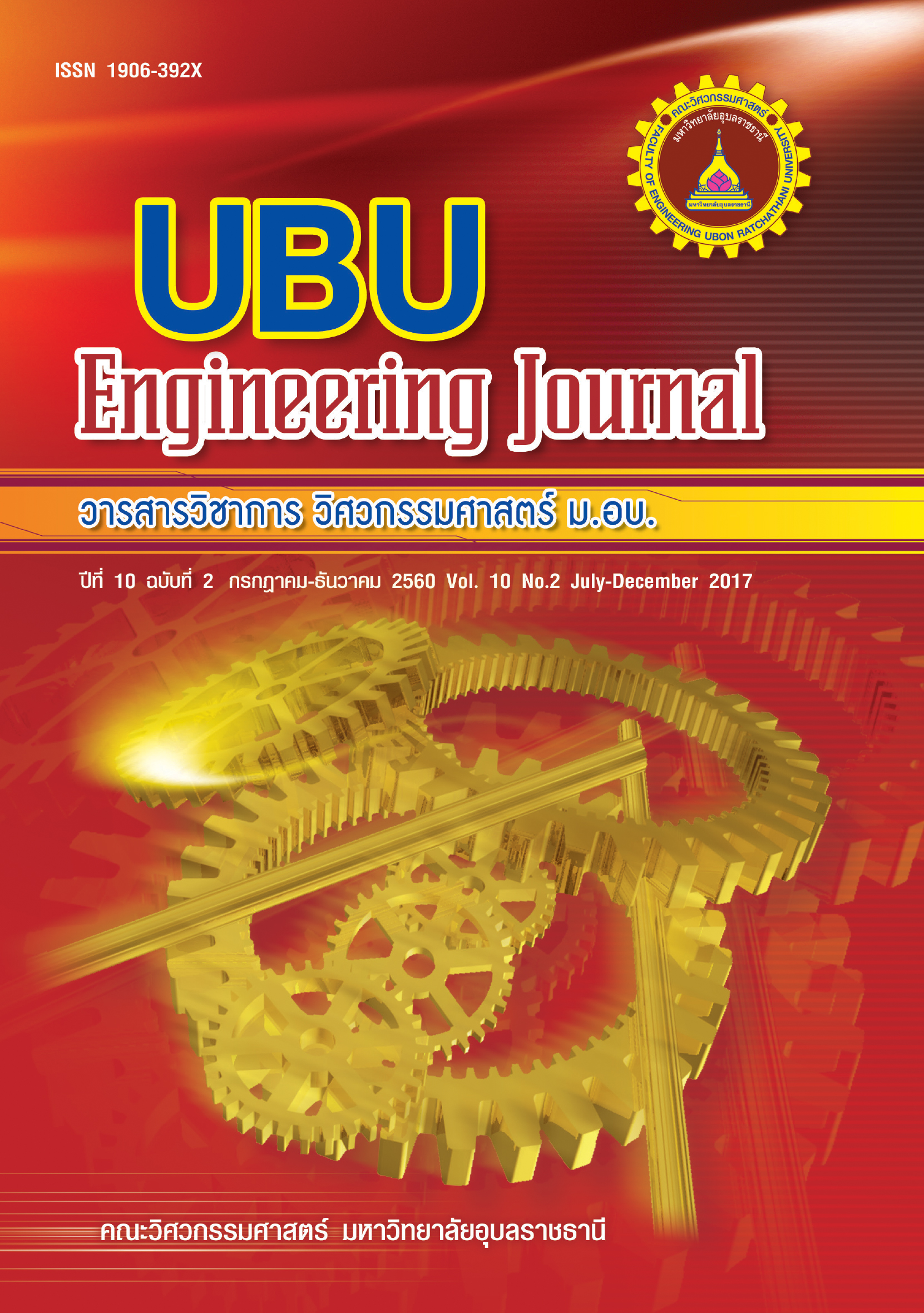การทบทวนวรรณกรรมเกี่ยวกับการวัดประสิทธิภาพระบบโลจิสติกส์และโซ่อุปทาน
Main Article Content
Abstract
In this academic article, a literature review on performance measurement of logistics systems and supply chain is presented. The results of the literature review reveal that, the performance measurement of supply chain focuses on measuring the effectiveness of supply chains in 3 aspects: effectiveness will focus on measuring the quality of raw materials or products, efficiency will focus on measuring the cost of logistics activities by using Activity Based Costing method, and the responsiveness will focus on measuring the response time to meet the needs of customers. Each type of organizational, supply chain are performing different operations. It's up to each organization to manage problems within their own organization, and then focus optimize performance throughout the whole supply chain.
Article Details
References
[2] เศรษฐภูมิ เถาชารี, ณัฎภัทรศญา เศรษฐโชติสมบัติ. การทบทวนวรรณกรรมเกี่ยวกับการวิเคราะห์และลดต้นทุนโลจิสติกส์ของอุตสาหกรรม SMEs ในประเทศไทย. วารสารวิชาการ วิศวกรรมศาสตร์ ม.อบ. 2558; 8(2): 124–135.
[3] รุธิร์ พนมยงค์. การจัดการโลจิสติกส์ในประเทศไทย. กรุงเทพฯ: สำนักพิมพ์เวลาดี; 2547.
[4] Stock JR, Lambert DM. Strategic logistics management. New York: McGraw-Hill; 2001.
[5] รุธิร์ พนมยงค์, นุจรี สุพัฒน์, ศิริวรรณ ไชยสูรยกานต์. การวิเคราะห์ต้นทุนโลจิสติกส์แบบ ABC. กรุงเทพฯ: ศูนย์ส่งเสริมธุรกิจในประเทศไทยของเจโทร; 2548.
[6] Vogt J, Pienaar W, Wit PD. Business logistics management: Theory and practice. Oxford: Oxford University Press; 2005.
[7] สมจิตร อาจอินทร์. รายงานวิจัยการศึกษาขอบเขตและความเหมาะสมการพัฒนาระบบ ERP/Logistics สำหรับข้าวหอมมะลิกลุ่มจังหวัดร้อยแก่นสาร. มหาวิทยาลัยขอนแก่น; 2549.
[8] รวิพิมพ์ ฉวีสุข. การจัดการโลจิสติกส์และโซ่อุปทานอาหาร. เป้าหมายของการจัดการโลจิสติกส์และโซ่อุปทาน. เข้าถึงได้จาก: https://aitm.agro.ku.ac.th. [เข้าถึงเมื่อ 21 ธันวาคม 2559].
[9] สุพจน์ เหล่างาม. การวัดสมรรถนะของโซ่อุปทาน. บทความโลจิสติกส์. เข้าถึงได้จาก: www.logisticscorner.com/index.php?option=com_content&view=article&id=578:measuring-supply-chain-performance&catid=41:supply-chain&Itemid=89 [เข้าถึงเมื่อ 14 ธันวาคม 2559].
[10] Thoucharee S, Pitakaso R. Performance measurement supply chain management of rice in the Northeastern part of Thailand. In: Proceedings of the 8th International Conference on Intelligent Manufacturing & Logistics systems (IML 2012), Ubon ratchathani; 2016: p. 378–385.
[11] สนั่น เถาชารี, ระพีพันธ์ ปิตาคะโส. การจัดการโลจิสติกส์และโซ่อุปทานข้าวในภาคตะวันออกเฉียงเหนือของประเทศไทย. วารสารวิจัย มข. 2012; 17: 125–141.
[12] สนั่น เถาชารี, วราภรณ์ จันทร์เวียง. โครงสร้างต้นทุนโลจิสติกส์ของเกษตรกรผู้ปลูกทุเรียนในเขตจังหวัดจันทบุรี. วารสารวิจัย มข. 2014; 19: 344–353.
[13] สนั่น เถาชารี, โพธิ์ทอง ประณีตพลกรัง, ธนวัฒน์ จุ่นหัวโทน. การจัดการโลจิสติกส์ข้าวในภาคตะวันออกเฉียงเหนือของประเทศไทย. ใน: การประชุมวิชาการระดับชาติราชภัฏเพชรบุรีวิจัยเพื่อแผ่นดินไทยที่ยั่งยืน ครั้งที่ 3, เพชรบุรี, ประเทศไทย; 2558: หน้า 250–258.
[14] พัชริน เจริญสุข, สำราญ ชำโสม, สนั่น เถาชารี, ศศินภา บุญพิทักษ์. การศึกษาโซ่อุปทานของทุเรียนในเขตจังหวัดจันทบุรี. ใน: การประชุมสัมมนาเชิงวิชาการประจำปีด้านการจัดการโลจิสติกส์และโซ่อุปทานครั้งที่ 13, ขอนแก่น, ประเทศไทย; 2556: หน้า 351–357.
[15] ปรารถนา ปรารถนาดี. รายงานวิจัยการจัดการโซ่อุปทานและโลจิสติกส์มันสำปะหลังในประเทศไทย. มหาวิทยาลัยเกษตรศาสตร์; 2552.
[16] อภิชาต โสภาแดง. รายงานวิจัยการศึกษาระบบการจัดการโซ่อุปทานของลำไยสดในประเทศไทย. มหาวิทยาลัยเชียงใหม่; 2551.
[17] เสาวนิตย์ จันทนโรจน์. การประยุกต์แบบจำลองโซ่อุปทานเพื่อการประเมินสมรรถนะของโซ่อุปทานในอุตสาหกรรมเม็ดพลาสติกรีไซเคิล: กรณีศึกษาโรงงานผลิตเม็ดพลาสติกรีไซเคิล. วารสารวิชาการมหาวิทยาลัยหอการค้าไทย. 2553; 30: 59–76.
[18] บวรวิทย์ โรจน์สุวรรณ. การจัดการโซ่อุปทานในอุตสาหกรรมกุ้ง: กรณีศึกษาอุตสาหกรรมกุ้งในธุรกิจขนาดกลางและขนาดย่อม. วิทยานิพนธ์วิทยาศาสตรมหาบัณฑิต. มหาวิทยาลัยธุรกิจบัณฑิตย์. 2552
[19] เศรษฐภูมิ เถาชารี, ณัฎภัทรศญา เศรษฐโชติสมบัติ. การทบทวนวรรณกรรมเกี่ยวกับการวิเคราะห์และลดต้นทุนโลจิสติกส์ของอุตสาหกรรม SMEs ในประเทศไทย. วารสารวิชาการ วิศวกรรมศาสตร์ ม.อบ. 2558; 8: 124–135.
[20] Hasan B, Bbhisham Y. Supply chain performance in electronics manufacturing industry. Appl. Mech Mater. 2014; 554: 633–637.
[21] Uma J, Lyonsb A, Lamb KSH, Chengc TCE, Pery CD. Product variety management and supply chain performance: A capability perspective on their relationships and competitiveness implications. International Journal of Production Economics. 2017; 187: 15–26.
[22] Wibowo MA, Sholeh NM. The analysis of supply chain performance measurement at construction project. Procedia Engineering. 2015; 125: 25–31.
[23] B Steffen, Schotz S, Petroschke M, Steinhilper R. Development of a performance measurement system for international reverse supply chains. Procedia CIRP. 2017; 61: 251–256.
[24] Abu Bakar AH, Hakim IL, Chong SC, Lin B. Measuring supply chain performance among public hospital laboratories. Int J Product Perform Manage. 2010; 59: 75–97.
[25] Aramyan LH, Oude LAG, Van Der Vorst JG, Van Kooten O. Performance measurement in agri-food supply chains: A case study. Supply Chain Manage : Int J. 2007; 12: 304–315.
[26] Balfaqih H, Yunus B. Supply chain performance in electronics manufacturing industry. Applied Mechanics and Materials. 2014; 554: 633–637.
[27] Bigliardi B, Bottani E. Performance measurement in the food supply chain: A balanced scorecard approach. Facilities. 2010; 28: 249–260.
[28] Bhagwat R, Chan FT, Sharma MK. Performance measurement model for supply chain management in SMEs. Int J Glob Small Bus. 2008; 2: 428–445.
[29] Thoucharee S, Pitakaso R. Mathematical Model of the Supply Chain Management of Rice in the Lower North-Eastern Region of Thailand. In: Proceedings of the 11th International Congress on Logistics and SCM systems 2016 (ICLS 2016). Bali, Indonesia; 2016. p. 407–414.
[30] Eskafi S, Roghanian E, Jafari-Eskandari M. Designing a performance measurement system for supply chain using balanced scorecard, path analysis, cooperative game theory and evolutionary game theory: A case study. Int J Ind Eng Comput. 2015; 6: 157–172.
[31] Galankashi MR, Memari A, Anjomshoae A, Ma'aram A, Helmi SA. Selection of supply chain performance measurement frameworks in electrical supply chains. Int J Ind Eng Manage. 2014; 3: 131–137.
[32] Kusrini E, Subagyo. Masruroh. Combining balanced scorecard and data envelopment analysis to design performance measurement for supply chain actor and regulator: A case study in innovative product in Indonesia. Industrial Engineering, Management Science and Applications. 2015: 551–562.
[33] Lauras M, Lamothe J, Pingaud H. A business process oriented method to design supply chain performance measurement systems. Int J Bus Perform Manage. 2011; 12: 354–376.
[34] Santiteerakul S, Sekhari A, Bouras A, Sopadang A. Sustainability performance measurement framework for supply chain management. Int J Prod Dev. 2015; 20: 221–238.
[35] Sellitto MA, Pereira GM, Borchardt M, RI da Silva, Viegas CV. A SCOR-based model for supply chain performance measurement: application in the footwear industry. Int J Prod Res. 2015; 53: 4917–4926.
[36] Charkha PG, Jaju SB. Designing innovative framework for supply chain performance measurement in textile industry. Int J Logist Syst Manage. 2014; 18: 216–230.

